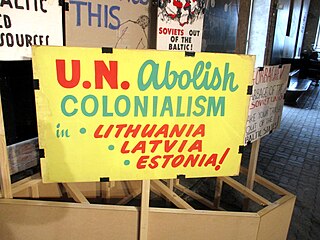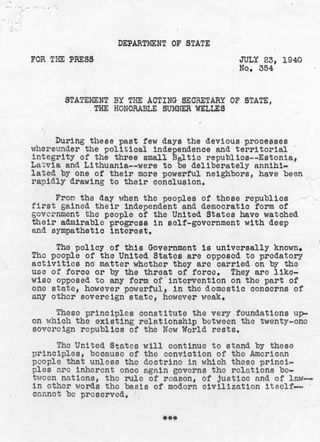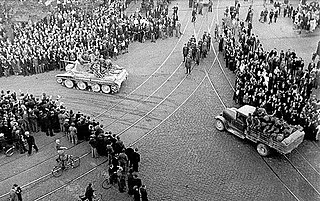Legation property
All three legations maintained at least one diplomatic property in the United States until the end of the Cold War. Latvia and Lithuania maintained their original legations in Washington, D.C., while Estonia maintained a consulate in New York City. [3] After World War II, the legation died out as a form of diplomatic representation, as countries upgraded them to embassies. However, the Baltic states did not control their own territory and could not receive a U.S. ambassador. By 1990, the three Baltic legations were the only remaining legations on the U.S. State Department's Diplomatic List. [4]
The Estonian legation in London was maintained until 1989, when financial pressure forced its sale. [5] The Latvian and Lithuanian legations continued their work. [6] The Baltic legations in Paris were transferred de facto to the Soviet Embassy. The Estonian legation was demolished in 1979, and the Latvian legation was recorded as a Soviet property in 1967. However, the Lithuanian legation remained registered to the prewar government of Lithuania, and the Soviet Embassy was unable to sell the building. [7]

The occupation of the Baltic states was a period of annexation of Estonia, Latvia and Lithuania begun by the Soviet Union in 1940, continued for three years by Nazi Germany after it invaded the Soviet Union in 1941, and finally resumed by the Soviet Union until its dissolution in 1991.

The Latvian diplomatic service in exile was the only governmental body of the Republic of Latvia which continued its activities during the Nazi and Soviet occupation of Latvia during 1940–1991. Latvian diplomats who were stationed in embassies and consulates at the moment of the occupation in 1940, refused to recognize the occupation and return to Soviet Latvia. They continued to formally represent the interests of Latvia in countries that did not recognize the Soviet annexation. After the restoration of Latvian independence in 1991, the diplomats started reporting to the restored Latvian Ministry of Foreign Affairs.

The Estonian government-in-exile was the formally declared governmental authority of the Republic of Estonia in exile, existing from 1944 until the reestablishment of Estonian sovereignty over Estonian territory in 1991. It traced its legitimacy through constitutional succession to the last Estonian government in power prior to the June 1940 Soviet invasion and occupation of the country. During its existence, it was the internationally recognized government of Estonia.

The three Baltic countries, or the Baltic states – Estonia, Latvia, and Lithuania – are held to have continued as independent states under international law while under Soviet occupation from 1940 to 1991, as well as during the German occupation in 1941–1944/1945. The prevailing opinion accepts the Baltic thesis that the Soviet occupation was illegal, and all actions of the Soviet Union related to the occupation are regarded as contrary to international law in general and to the bilateral treaties between the USSR and the three Baltic countries in particular.
The Select Committee to Investigate Communist Aggression and the Forced Incorporation of the Baltic States into the U.S.S.R., also known as the Kersten Committee after its chairman, U.S. Representative Charles J. Kersten was established in 1953 to investigate the annexation of Estonia, Latvia, and Lithuania into the Soviet Union. The committee terminated March 4, 1954, when it was replaced by the Select Committee on Communist Aggression.

Anatols Dinbergs was one of the preeminent career diplomats of Latvia. He entered service in Latvia's Foreign Ministry in 1932. Dinbergs remained abroad when the Soviet Union occupied Latvia, serving in the Latvian Legation in Washington, D.C., after World War II ended. Dinbergs assumed the highest diplomatic post, that of chargé d'affaires, in 1970 and represented Latvia's sovereign interests in exile until Latvia reestablished its independence in 1991. As head of the Latvian diplomatic service abroad, Dinbergs was appointed Latvia's first ambassador to the United Nations and subsequently Latvia's first ambassador to the United States. After retirement, he served as Counselor to the Latvian Embassy in Washington, D.C., until his death in 1993.

The Embassy of Australia in Moscow is the diplomatic mission of Australia to the Russian Federation. The current head of post and Ambassador of Australia to the Russian Federation is John Geering. The embassy serves as the diplomatic mission for Australia to the Russian Federation, Armenia, Belarus, Kazakhstan, Kyrgyzstan, Tajikistan, Turkmenistan and Uzbekistan. The chancery is located at 10A/2 Podkolokolny Lane in the Tagansky District of Moscow.

Estonia was occupied on 17 June 1940, by Red Army troops and was forcibly incorporated into the Soviet Union on 6 August 1940. The United States never recognized the illegal annexation of the three Baltic countries – Estonia, Latvia, and Lithuania – in conformity with the principles of the Stimson Doctrine, and more than 50 countries followed this position.

Foreign relations exist between Australia and Estonia. Australia first recognised Estonia on 22 September 1921. Australia was among the first countries to re-recognise Estonia's independence on 27 August 1991. Both countries re-established diplomatic relations on 21 November 1991.

The Welles Declaration was a diplomatic statement issued on July 23, 1940, by Sumner Welles, the acting US Secretary of State, condemning the June 1940 occupation by the Soviet army of the three Baltic countries – Estonia, Latvia, and Lithuania – and refusing to diplomatically recognize their subsequent annexation into the Soviet Union. It was an application of the 1932 Stimson Doctrine of nonrecognition of international territorial changes that were executed by force and was consistent with US President Franklin Roosevelt's attitude towards violent territorial expansion.
The Sovietization of the Baltic states is the sovietization of all spheres of life in Estonia, Latvia and Lithuania when they were under control of the Soviet Union. The first period deals with the occupation from June 1940 to July 1941, followed by the German occupation during World War II. The second period of occupation covers 1944 when the Soviet forces pushed the Germans out, until the end of the Soviet occupation in 1991 when the three countries restored full independence.

The Soviet occupation of the Baltic states covers the period from the Soviet–Baltic mutual assistance pacts in 1939, to their invasion and annexation in 1940, to the mass deportations of 1941.

The Soviet Union (USSR) occupied most of the territory of the Baltic states in its 1944 Baltic Offensive during World War II. The Red Army regained control over the three Baltic capitals and encircled retreating Wehrmacht and Latvian forces in the Courland Pocket where they held out until the final German surrender at the end of the war.

Embassy of Lithuania in Washington, D.C., is the diplomatic mission of the Republic of Lithuania to the United States. It is located at 2622 16th Street Northwest, Washington, D.C., in the Meridian Hill neighborhood.
The Embassy of the United States in Tallinn, Estonia, is located at the chancery building on Kentmanni Street. This building housed the U.S. legation to Estonia from April 1, 1930 until September 5, 1940. The U.S. Mission to Estonia resumed operations in the same building on February 6, 1992.
The Diplomatic Service of the Republic of Lithuania is the part of the governmental service tasked with enforcing the foreign policy set by the President, the Parliament, and the Government of the Republic of Lithuania. The head of the service is the Foreign Minister.

Latvia–Taiwan relations, also retroactively known as ROC–Latvian relations date back to August 16, 1923, when the Republic of China recognized Latvia de jure, in that period when the island of Taiwan was under Japanese colonial rule. After the Soviet occupation of Latvia in 1940, the ROC is one of the few countries that did not recognize Latvia's incorporation into the Soviet Union.

Foreign relations exist between Australia and Latvia. Australia first recognised Latvia on 22 September 1921 and was among the first countries to re-recognise Latvia's independence on 27 August 1991. Both countries re-established diplomatic relations on 21 November 1991. Australia is represented in Latvia through its embassy in Stockholm, Sweden and an honorary consulate in Riga. Latvia has had an embassy in Canberra since October 2021, and also has honorary consulates in Sydney, Brisbane, Adelaide, Melbourne and Perth.

Foreign relations exist between Australia and Lithuania. Australia was among the first countries to re-recognise Lithuania's independence on 27 August 1991. Both countries formally established diplomatic relations on 6 November 1991. Australia is represented in Lithuania through its embassy in Warsaw, Poland. Lithuania has had an embassy in Canberra since 2021.

The Taipei Mission in the Republic of Latvia represents the interests of Taiwan in the Republic of Latvia in the absence of formal diplomatic relations, functioning as a de facto embassy.
















